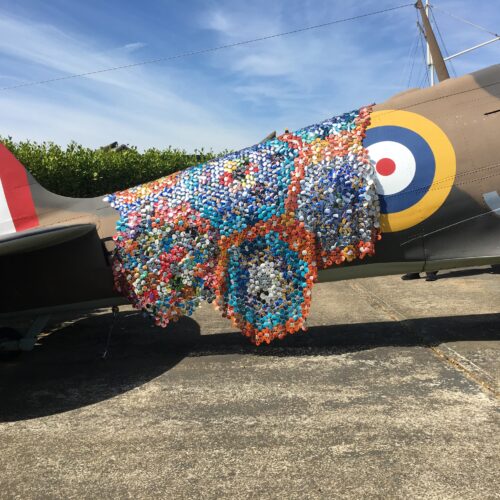
Take the Plunge – Weave Some Tapestry!
Several times lately, I’ve been asked for help by students really struggling with the weaving section of Textiles 1. Apologies to those tutors and students who are weavers, but this is an area which causes a lot of headaches for many. I think in all fairness, some of this is probably down to preconceived ideas of how difficult it might be.

I have to admit to dreading this section myself, if I could have bypassed it, I would have. But what a shame that would have been, as I learned so much from doing it (not brilliant, but got there) and quite enjoyed it too. In actual fact the instructions in the course book take you through the whole learning process step by step in a very gentle way. Weaving is more technical than other areas, perhaps not so given to improvisation, at least to start with. You do need to warp up the tapestry frame and so on, but in practice, its easier that it initially looks. There are some excellent books out there to help, not least a new one by Joanne Soroka, a tapestry weaver and mixed textile artist, an OCA tutor at one time.

I was lucky enough to have her as my tutor on Textiles 1 and a sheepish phone call to her helped me sort out the warping of the tapestry loom – her book, Tapestry Weaving: Design and Technique is written along similarly efficient and helpful lines. The miniature piece of tapestry weaving opposite, by Joanne, shows just how effective a small piece like this can be at conveying both energy and ideas. Notice (from her website) how closely related her collaged pieces are to her weaving – a great technique to use in developing design ideas.
If you’re in any doubt as to how creative tapestry weaving can be, have a look at the work of Joan Baxter, who incorporates laminated photos and other things into her tapestry weaving to give really vibrant, exciting effects which sing out with colour. Jilly Edwards uses tapestry in quite unconventional ways (as below) incorporating – printed ephemera, embroidery and drawings. Click on the magazines in the Articles and reviews section of her site to read articles about her work, lots of examples and some glimpses of her sketchbooks.

Maybe the slow, steady rate it calls one to work at, and the need to plan much more, are part of the problem; aspects which seem contrary to the excited, spontaneous and expressive work in say – free machine embroidery? You do need to plan your final design, if merely because unpicking a load of weaving is as time consuming as doing the actual work in the first place. But a large section of the assignment involves exploring new and unlikely materials, plastics, papers and so on – where it’s almost impossible to be too exacting -and you can really let rip. A strong element of improvisation and expressiveness can be developed once you’ve got those initial key steps under your belt. In fact the second option for the final piece is all about being expressive; creating a mood-board and finding textures and colours which express that mood; so you can be as free as you like within the given format. There are technical things to remember, but then your sewing machine won’t work unless its threaded up properly and your paints will wash out of fabric unless you read and applied the instructions correctly. We tend to forget that we learned these once, maybe struggled with the concepts, but overcame them and probably went on to set ourselves even greater challenges.
To prove the point here is some work by Textiles 1 student Carol Baker, who described at the beginning of her logbook notes on weaving her “reluctance to actually do the exercises” , and how she “gritted her teeth” to complete the assignment”.

To her own utter surprise, by the very end she says “when I first started I thought I would never do any more weaving if I could help it, but I found I enjoyed weaving with wools and would do this again”. Have a look at her final sample based on her own photos of sunsets, complete here with mood-board, yarn windings and charted design layout. Tapestry weaving (excuse the bad pun) can be uncharted waters, but look at what can result – vibrant, exciting work such as here, an a personal challenge conquered. Plunge in and see what happens, chances are you will really surprise yourself!






Having completed the weaving project for Textiles 1 in November time I found this to be a really relevant article! I too felt the weaving was an arduous module, however as my skills developed I found it to be quite a meditative process. I also found “warping up” to be incomprehensible at first, but once done I felt I could make good progress.
I am even voluntarily incorporating some needle weaving into my current project – something I would not have imagined at the commencement of the weaving module!
Thank you for highlighting this particularly challenging aspect of the course.
Hi Miriam,
Its good to hear you got there in the end! Sounds like you’re really putting the experience to good use as well. Good luck with the rest of the course!